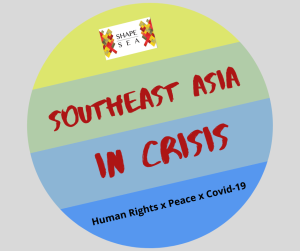Angelyn E. TurianoBroadcasting student, Ateneo de Naga UniversityThePillars Publication
 The Duterte administration mirrored the wrath that happened under the Marcos regime”systemic oppression, which made thousands of people march the streets of EDSA 35 years ago.The Martial law story remains unfinished”it continuous to unravel the theatre of torture and horror under the presidency of Duterte, yet through the power of a collective struggle, the new revolutionaries are determined to mark down another narrative.On the liberation of the Filipino massesThe bloodshed of the Filipino people will always be remembered”the student martyrs, the journalists, political prisoners, farmers, innocent people, and all those that are deprived from their right to see the new face of democracy. The EDSA People Power Revolution that happened 35 years ago where people marched in solidarity with the same aspirations to liberate the country from dictatorship. It is indeed the collective action of the Filipino masses that championed the restoration of democracy.The alarming accounts of torture, killings, disappearances, and harassments that occurred even before the big mass movement challenges the ideation of EDSA People Power as a ˜bloodless revolution. In fact, revolutions happen through bloodshed, a thought quite disturbing as it encapsulates the idea of violent extremism. Though the EDSA Revolution only changed the political climate of the nation, and has left the system unchanged, poverty and oppression remained yet it does not disregard the fact that the people’s power is a manifestation of a united citizenry.From the grave of Philippine historyThe rise of a Marcos-like fascistic system manifests in the current regime of Duterte, all rooted from the anti-democratic policies such as Jeepney Phaseout, Rice Liberalization, K-12, and similar oppressive policies that rippled its effects to people under the poverty line. Media coverages are censored and altered. Journalists, news writers, and other media practitioners seemed to experience grave harassment incidents now that the draconian law, Terror Law, has been passed which institutionalized red-tagging among progressive groups and dissenters.An administration that plays blind and deaf to the battle cry of the masses usually sounds the alarm for the oppressed to organize themselves and take necessary actions. It is engraved in the history of Philippine protests the peaceful march of farmers, the Kilusang Mambubukid ng Pilipinas, also known as KMP trooped to Mendiola in the hopes of being heard by the Cory administration ended up as a violent protest as troops aligned as human barricades and started to take arms against protesters. In 3 minutes, 7 farmers were killed.The current administration seemed to pattern various forms of fascism from the Marcos ruling. Say, industrialization and beautification equates to increase of economic stability, one manifestation that honed the past generation to think that the Marcos era was indeed a ˜Golden Age while poverty among the masses were disregarded. As seen in the Duterte administration, the Build Build Build program aims to focus more on infrastructure, only to serve the interest of the capitalists and foreign investors.Duterte shadows the atrocities of the past. The Philippines will never forget the savagery of the Marcos era.The battlefieldThe democratic space paved its way for progressive groups and activists their right to assemble. Since the Marcos era, big mass actions were staged not only in Manila but also in different provinces all over the Philippines to exhibit solidarity will under suppression. Back in 1986 when people rallied for their basic human rights, it created the idea that the power of the people to mobilize can be strengthened and is also sketched out under the presidency of Duterte. In fact, protests and calls were much more reinforced by progressive groups because of how the administration behaves. Say, the junking of the Terror Law, the call for mass testing, the demand for free and accessible education, and also a calibrated and strategic government response has echoed the streets since the pandemic started. Incompetency is seen to be the root cause.Collective struggle, collective strengthThe necessity of activism ended a dictatorial regime. It is only through collective action people can unite as a resisting force under an authoritarian rule. Branded as new revolutionaries, activists together with the toiling masses exhibits the flames of patriotism.The COVID19 pandemic has restricted mobility yet it did not hinder the youth to fight back. In fact, people are rattled enough that a virus did not scare them but a tyrant. When people are dying right in front of the eyes of many, it is necessary to take dissent to the streets, to rally for the Filipino masses.To struggle collectively”because the power of a collective struggle is grounded to aspirations for liberation, and the goal will be handed down from one generation to another.The voices of the Filipino masses that echoed the streets 35 years ago, will continuously mimic in every alley of the country under a fascist regime until we can finally be freed from a tyrannical system which we are currently enslaved in.As what Raissa Robles said in her book ˜Martial Law: Never AgainFor all the human rights victims of the Marcos dictatorship whose sacrifices we are building on today, and for the unborn generation who might be asked one day to make the same sacrifice.
The Duterte administration mirrored the wrath that happened under the Marcos regime”systemic oppression, which made thousands of people march the streets of EDSA 35 years ago.The Martial law story remains unfinished”it continuous to unravel the theatre of torture and horror under the presidency of Duterte, yet through the power of a collective struggle, the new revolutionaries are determined to mark down another narrative.On the liberation of the Filipino massesThe bloodshed of the Filipino people will always be remembered”the student martyrs, the journalists, political prisoners, farmers, innocent people, and all those that are deprived from their right to see the new face of democracy. The EDSA People Power Revolution that happened 35 years ago where people marched in solidarity with the same aspirations to liberate the country from dictatorship. It is indeed the collective action of the Filipino masses that championed the restoration of democracy.The alarming accounts of torture, killings, disappearances, and harassments that occurred even before the big mass movement challenges the ideation of EDSA People Power as a ˜bloodless revolution. In fact, revolutions happen through bloodshed, a thought quite disturbing as it encapsulates the idea of violent extremism. Though the EDSA Revolution only changed the political climate of the nation, and has left the system unchanged, poverty and oppression remained yet it does not disregard the fact that the people’s power is a manifestation of a united citizenry.From the grave of Philippine historyThe rise of a Marcos-like fascistic system manifests in the current regime of Duterte, all rooted from the anti-democratic policies such as Jeepney Phaseout, Rice Liberalization, K-12, and similar oppressive policies that rippled its effects to people under the poverty line. Media coverages are censored and altered. Journalists, news writers, and other media practitioners seemed to experience grave harassment incidents now that the draconian law, Terror Law, has been passed which institutionalized red-tagging among progressive groups and dissenters.An administration that plays blind and deaf to the battle cry of the masses usually sounds the alarm for the oppressed to organize themselves and take necessary actions. It is engraved in the history of Philippine protests the peaceful march of farmers, the Kilusang Mambubukid ng Pilipinas, also known as KMP trooped to Mendiola in the hopes of being heard by the Cory administration ended up as a violent protest as troops aligned as human barricades and started to take arms against protesters. In 3 minutes, 7 farmers were killed.The current administration seemed to pattern various forms of fascism from the Marcos ruling. Say, industrialization and beautification equates to increase of economic stability, one manifestation that honed the past generation to think that the Marcos era was indeed a ˜Golden Age while poverty among the masses were disregarded. As seen in the Duterte administration, the Build Build Build program aims to focus more on infrastructure, only to serve the interest of the capitalists and foreign investors.Duterte shadows the atrocities of the past. The Philippines will never forget the savagery of the Marcos era.The battlefieldThe democratic space paved its way for progressive groups and activists their right to assemble. Since the Marcos era, big mass actions were staged not only in Manila but also in different provinces all over the Philippines to exhibit solidarity will under suppression. Back in 1986 when people rallied for their basic human rights, it created the idea that the power of the people to mobilize can be strengthened and is also sketched out under the presidency of Duterte. In fact, protests and calls were much more reinforced by progressive groups because of how the administration behaves. Say, the junking of the Terror Law, the call for mass testing, the demand for free and accessible education, and also a calibrated and strategic government response has echoed the streets since the pandemic started. Incompetency is seen to be the root cause.Collective struggle, collective strengthThe necessity of activism ended a dictatorial regime. It is only through collective action people can unite as a resisting force under an authoritarian rule. Branded as new revolutionaries, activists together with the toiling masses exhibits the flames of patriotism.The COVID19 pandemic has restricted mobility yet it did not hinder the youth to fight back. In fact, people are rattled enough that a virus did not scare them but a tyrant. When people are dying right in front of the eyes of many, it is necessary to take dissent to the streets, to rally for the Filipino masses.To struggle collectively”because the power of a collective struggle is grounded to aspirations for liberation, and the goal will be handed down from one generation to another.The voices of the Filipino masses that echoed the streets 35 years ago, will continuously mimic in every alley of the country under a fascist regime until we can finally be freed from a tyrannical system which we are currently enslaved in.As what Raissa Robles said in her book ˜Martial Law: Never AgainFor all the human rights victims of the Marcos dictatorship whose sacrifices we are building on today, and for the unborn generation who might be asked one day to make the same sacrifice.





